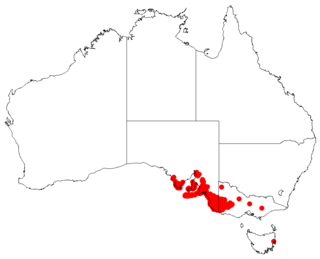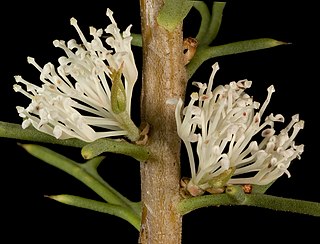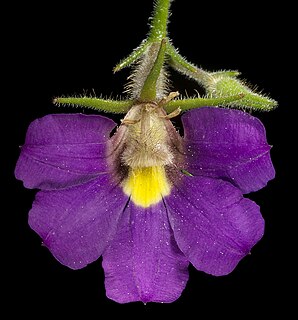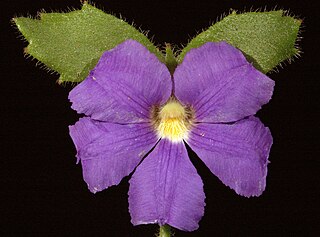
Dampiera is a genus of plants in the family Goodeniaceae which are endemic to Australia occurring in all states. They are herbaceous plants or small shrubs which have blue or purple flowers with yellow centres. The genus is named for William Dampier, an English sea captain and scientific observer. Dampiera diversifolia is sometimes grown in gardens as an ornamental.

Dampiera linearis, commonly known as common dampiera or wedge-leaved dampiera, is an erect perennial herb in the family Goodeniaceae. The species, which is endemic to the south-west of Western Australia, grows to between 15 and 60 cm high, with its blue to purple flowers appearing between July and December. It adapts readily to cultivation, particularly containers such as hanging baskets.

Dampiera dysantha, the shrubby dampiera, is an undershrub in the family Goodeniaceae. The species grows to 70 cm high The flowers are blue, or occasionally white to lilac and are covered on the outside with grey and rusty hairs. These generally appear between September and October in its native range.

Hakea rugosa, commonly known as wrinkled hakea or dwarf hakea, is a shrub of the family Proteaceae native to Australia. It has sharp needle-shaped leaves and white or cream fragrant flowers in profusion from August to October.

Hakea varia, commonly known as the variable-leaved hakea, is a shrub of the family Proteacea and endemic to Wheatbelt, South West, Great Southern and Goldfields-Esperance regions of Western Australia. It is a dense prickly shrub with creamy-white or yellow flowers and variable shaped leaves.

Hakea rhombales, commonly known as walukara, is a shrub in the family Proteacea. It has red, pink or purple flowers and is endemic to Western Australia and the Northern Territory.

Scaevola basedowii is an erect multi-stemmed shrub in the family Goodeniaceae, endemic to Western Australia, the Northern Territory and South Australia.

Scaevola browniana is a shrub in the family Goodeniaceae, endemic to Western Australia, the Northern Territory and Queensland.

Scaevola glandulifera, the viscid hand-flower, is a shrub in the family Goodeniaceae, endemic to Western Australia.

Scaevola plumieri is a species of plant in the family Goodeniaceae which grows on coastal dunes in the tropics and subtropics.

Scaevola nitida is an erect shrub in the family Goodeniaceae, native to Western Australia. It grows to a height of 0.3 to 3 m, and its blue-purple flowers may be seen from August to December.

Scaevola humifusa is a prostrate shrub in the family Goodeniaceae, native to Western Australia. It grows to a height of 0.01 to 0.5 m, and its white-cream/white-blue flowers may be seen from August to November or January.

Scaevola parvifolia is an erect, many stemmed perennial in the family Goodeniaceae, which is native to Western Australia, the Northern Territory, Queensland and South Australia. It grows to a height of 0.6 m, and its blue-purple flowers may be seen from March to October.

Scaevola phlebopetala, commonly known as velvet fanflower, is a herb in the family Goodeniaceae and is endemic to Western Australia.

Scaevola pilosa, commonly known as the hairy fan-flower, is a perennial herb in the family Goodeniaceae. It is endemic to the southwest of Western Australia.

Brachyscome dentata, commonly known as lobe-seed daisy, is a tufted perennial herb in the family Asteraceae and is endemic to Australia. It has mostly white or mauve daisy-like flowers, a yellow centre and pale green leaves. It is endemic to Australia.

Scaevola repens is a shrub in the family Goodeniaceae, endemic to the south west of Western Australia.

Dampiera candicans is a plant in the family Goodeniaceae, native to Western Australia and the Northern Territory.

Dampiera alata is a plant in the family Goodeniaceae, native to Western Australia.

Goodenia gibbosa is a species of flowering plant in the family Goodeniaceae and is endemic to central Australia. It is a prostrate to low-lying, often stoloniferous herb covered with soft hairs. It has elliptic to lance-shaped leaves and small groups of yellow flowers.



















